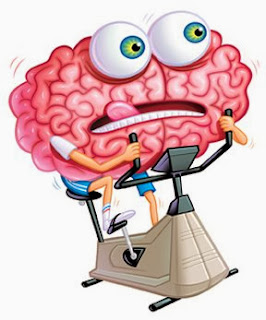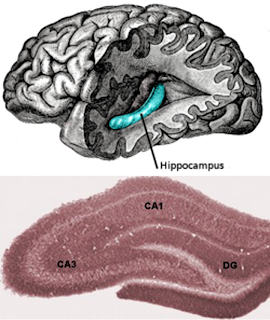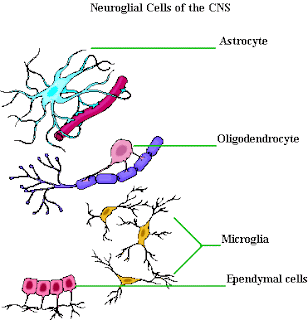Biology concepts – learning, memory, attention, concentration, hippocampus, neurotransmitters, neurotrophins, executive function, processing speed, exercise
In a study from 2011, researchers took overweight kids and had them start exercising. Those that had at least 30 minutes of physical activity each day showed increased hippocampus size, and significant improvement on a CAS planning test, an alternative to the standard IQ test.
Planning basically means that their executive function (planning, reasoning, and decision making skills) had improved markedly. They also performed much higher on a math test, even though no additional math instruction had been given.
Exercise has impacts on memory, learning, attention, concentration, and processing speed. So now we know what we are talking about when we say exercise helps learning. Oh – you won’t just take my word that exercising helps? Good, always ask for evidence.
Let’s look at studies just from 2013, although there are many older studies. One study found that a single bout of moderate exercise allowed participants to more accurately complete a test on memory, reason, and planning - and it took them less time. Another study indicated that exercise reduced the loss of cognitive function in middle-aged women. Yet another publication talked about how master athletes (over 50), have a larger brain volume and better cognitive function as compared to their sedentary counterparts.
We can go on. Exercise has been shown to support the cellular structure of the white matter (myelinated) neurons of the cerebral cortex in patients with vascular disease, important for higher thinking functions. And another study shows that processing speed is increased after starting a regular regimen of cardiovascular activity.
Nine-ten year old kids that exercised regularly had 12% larger hippocampi (plural of hippocampus, part of brain for learning and memory). They were faster on recall tests and they learned new information faster.
So now that you are convinced that exercise does help cognitive functions, the question still remains as to how exercise carries out this miracle. The first thing to get clear is the difference between memory and learning. It might seem that they are the same thing; you have some experience, either verbal, aural, visual, etc. and if you remember it, then you have learned it. But there are subtle differences.
Specialists define learning as a process that will modify a subsequent behavior. Memory, on the other hand, is the ability to remember past experiences. Memory is the record left by a learning process, so you need to have memory to learn. You learn to play piano by studying the notes and the instrument, but you then play it by using your memory to retrieve the notes and fingering that you have learned.
Back to the mechanisms of how exercise help memory and learning. The easy explanation is that exercise helps you sleep, improves your mood, and drives more oxygen to the brain. These undoubtedly help you study better or even notice more that can be used to build knowledge. These are the factors my dad counted on when he went running. But there’s much more.
The hippocampus is important for learning and memory. Many studies of exercise and cognitive function have shown increases in the size of this part of the brain in exercise participants. Those kids that increased their “IQ,” they had an increased hippocampus. So did mice from studies in the 1990’s.
Exercise upregulates neurogenesis, oxygenation, synaptic plasticity, neurotransmitter populations, myelination, processing speed, and long-term potentiation (LTP). O.K., that’s a lot of big words, so let’s take them one at a time. Remember that all these things are linked together. Plasticity, neurogenesis, and LTP apply to memory. Neurogenesis and processing speed apply to new learning and executive function. Neurotransmitters, plasticity and oxygenation combine to affect attention.
Neurogenesis
A lot of the benefits from cardiovascular exercise come through the making of new neurons (neurogenesis). Yep, this is a huge exception to the rule that central nervous system neurons last your entire life and can’t be recovered or new ones produced. Neurogenesis is how the hippocampi of all those exercisers got bigger.
Regular exercise induces neurogenesis through action of brain chemicals, trophins and NTs. We talked about brain-derived neurotrophic factor (BDNF) 2 weeks ago with respect to mood and we said we revisit this factor. This neurotrophin actually stimulates your brain to make new neurons! More neurons means more connections, and more potential learning.
For most all of the cognitive functions, the lynchpin seems to be BDNF. How does exercise increase BDNF? We aren’t sure yet. It may be that exercise is a stress, this increases the calcium flowing into the brain. The calcium activates many transcription factors, and BDNF is known to require calcium for transcription.
But nothing is ever simple. It is probable that serotonin, IGF-1, and BDNF are all needed to increase neurogenesis in the hippocampus. Inhibitors of any one of these drastically reduce the amount of exercise-induced neurogenesis.
Plasticity
Think of plasticity as a general process, the altering of neurons and their connections. It involves making more neurons (neurogenesis) and the number (developmental plasticityor synaptogenesis) and orientation of the dendritic connections with other neurons (synaptic plasticity).
Plasticity is crucial to learning and to memory, since all learning and memory is just a map of connected circuits that work together to access certain information. It is the number and pattern of the connections that determine the amount retained. More connections must help this process.
Long term potentiation
LTP is for memory and learning – the reinforcing of neural connections to make them stronger. Exercise increases LTP, probably through synaptic plasticity, more connections between two neurons would help reinforce each other when they fire. We talked about LTP last year, so read that post and know that exercise increases it.
Unfortunately, for best increases in memory the exercise must be long term. In a 2013 study, neurogenesis was apparent only 14 days after initiation of exercise, and these were immature neurons. LTP wasn’t increased appreciably until 56 days.
Processing speed
Increased speed probably comes through increased IGF-1 and oxygenation, and their effects on the support cells in the brain. Oligodendrocytes and astrocytes help the neurons do their job at peak efficiency. In particular, oligodendrocytes make the myelin sheath that increases transmission speed.
Attention and concentration
Exercise also helps your attention and concentration. And no, these two aren’t exactly the same. They’re more closely related than memory is to learning, but there are still some differences. Both are important for making you smarter, because only by focusing do we take information in – you have to notice something to learn it.
When you are in a room full of people talking, you can still follow the conversation between yourself and one other person. This is one of several different forms of attention. In general, attention is a thinking process for directing and maintaining awareness of stimuli in one’s environment.
Concentration is the ability to control attention for a sustained period. Attention shifts as we wander from thought to thought about different things in our mind or environment, but concentration requires attention to one thing without wandering. In more clinical terms, concentration is a combination of two types of attention; sustained attention and selective attention.
Sustained attentionis staying on task, keeping your mind on a single task over time. Selective attention is more about how you pick what you pay attention to. If there are many activities going on within range of your sense, but you focus on one thing and pay no attention to the others, that is selective attention.
It turns out that increased dopamine, serotonin, and norepinephrine in the brain, and particularly the RAS is crucial for attention and concentration. And we talked two weeks ago about how exercise increases all these. In ADHD, they give drugs (methylphenidate) that increase the apparent levels of dopamine. This helps us make sense of studies that show regular exercise alleviates the symptoms of ADD/ADHD.
One last point that I find interesting. The type of exercise seems to make a difference for the increase in neurotrophins. A 2012 studyshowed that rats that ran on exercise wheels had increased BDNF in the hippocampus, but rats that lifted weights (climbed ladders with weights on their tails) increased only IGF-1. The two proteins work in different pathways, so rat studies show us that it is best to include both aerobic and resistance training in your exercise program. And a rat shall lead them.
Next week, can you die from not getting enough sleep. Yep, and that's not the weirdest part of fatal familial insomnia.
For a good resource on brain structure and function, see the Open College’s interactive brain.
Tam ND (2013). Improvement of Processing Speed in Executive Function Immediately following an Increase in Cardiovascular Activity. Cardiovascular psychiatry and neurology, 2013 PMID: 24187613
For more information or classroom activities, see:
Most of the information for this post comes from recent scientific journals, here is more general information from the internet.
Memory classroom activities –
Hippocampus –
BDNF –
Neuroglia –





